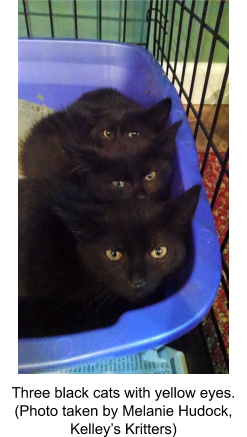Stigmatizations of black cats

December 3, 2020
Although a cat’s fur shouldn’t really matter in the long run, black cats have always had a stigmatization that made people stray further from them in hopes of “not being cursed.” The link between black cats and witchcraft has permanently tainted the reputation of black cats despite only a theory connecting the two.
Witchcraft is a broad term for the belief and practice of magic. Throughout history,witchcraft would be seen with Satanism and worship of the devil. Although there are actual Satanic witches, witchcraft was widely misinterpreted back in the late 1960’s. With delusions such as a long nose, a giant wart, green skin, long nails curling around a broomstick that they fly on at night. And that they would worship demons, had ogres, ate children and babies and performed other acts. SYFY WIRE writes about the misconceptions in their article “Real Witches and Pagans Break Down Netflix’s Chilling Adventures of Sabrina” by Jennifer Vineyard. Vineyard defines paganism and says, “Not all Pagans are witches, and not all witches are Wiccan. And the majority of Pagans, Wiccans, and witches have nothing to do with Satan, which is a Christian construct…While there are some cultish Satanists who do believe in a literal Satan,…their belief system is based on free will, self-empowerment, and consent. Those ideals are espoused in the real-world Church of Satan and in the Satanic Temple, where the idea of a fallen angel is an abstract concept.”
People who studied the Witch Trials of Salem theorize that the development of this stereotype and superstition was purely because the Church inquisitors were against their practices, others believed it was just because the Christians back then were afraid. But because of these illusions people distrusted anything that they thought to be associated with them, including black cats.
Abigail Tucker explains the history between cats and witchcraft in her article “The Spooky History of how Cats Bewitched Us” on the Washington Post. Cats are known to have mysterious behavior and exotic looks. Things like how cats tend to be more alert and active during the night, which would make them more accessible for midnight gatherings another superstition that tends to gravitate towards witches. Cats are also prone to hiding in odd and bizarre places, especially in dark places.They make sudden and startling movements/noises that scare others. Their eyes glow due to a mirrored structure behind their retinas, promoting night vision. Although this glow is not uncommon between the cat family, Christian’s tend to associate this characteristic with a serpent, the animal Satan had made his first Biblical appearance as.
Although these superstitions could be taken on form of any cat, the people back then chose black cats. Kate Smith, a color expert, says “Black represents evil, darkness, night, and despair…It’s a symbol of the eternal struggle between day and night, good and evil, right and wrong.” Smith also goes into detail about the negative connotations of the color black, it being associated with mourning throughout the world. Smith says, “A black mark on your record reveals wrongdoing, and we characterize bed people as being black-hearted. Black is frightening, as it conceals, rather than illuminates, and the cover of night is a perfect scenario for bad behavior. Too much black in design can be overwhelming and dull.”
The Puritan Pilgrims constantly persecuted black cats, even practiced the burning of black cats on Shrove Tuesday (The day before Ash Wednesday) to protect their home from fires. Black cats were constantly used as a decor and as a Halloween symbol right alongside the stereotyped witch.
Because of this stigma that has been around for generations people tend to stray away from black cats. Although it might not be everyone’s reasoning for staying away, the stigmatization still tends to affect black cats. Hannah, a writer at Peta2 gives out data on black cats on her article Black Cats Less Likely to be Adopted, Studies Shown, “Black cats are two-thirds less likely to get adopted than white cats and only half as likely to be adopted as tabby cats.” With overpopulation, “nearly 71 percent of [cats in shelters] are euthanized, the majority of which are black cats.”
With Christmas coming up, using this holiday could help fluctuate adoption for black cats. You can adopt a black cat this holiday season, advocate in your community for animal cruelty cases to be investigated thoroughly and help promote black cats on social media webpages such as Instagram, TikTok, or Snapchat.
